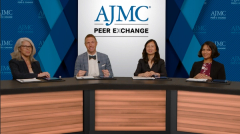
Monitoring and Managing Adverse Effects With Oral SERDs
Drs Vidula and Lu discuss how to monitor patients for adverse effects or oral selective estrogen receptor degraders (SERDs) and how those adverse effects are managed.
Episodes in this series

Ryan Haumschild, PharmD, MS, MBA: One of the biggest takeaways we’re reviewing as a whole is that while elacestrant had adverse effects that we saw in the clinical trial, and we’re able to evaluate those, there are a lot more oral SERDs [selective estrogen receptor degraders] coming. A lot more information is coming as well, as we continue to build and monitor our patients. Dr Lu, how do you monitor patients for the adverse effects of oral SERDs? You touched on this a little earlier, but if you could review it with us again, it would be really beneficial.
Janice Lu, MD: For oral SERDs, adverse effects include nausea, vomiting, fatigue, decreased appetite, arthralgia, and a small percentage have hyperlipidemia. When I see my patients, I’ll tell them that the good thing is that it’s oral, so there’s no injection—you don’t have to worry about that. The second part is that you don’t have to see me every 2 to 4 weeks because of the injection. But when I see adverse effects, I discuss thoroughly how to manage that. I also tell them that for nausea, about 35% of patients have some kind of nausea; it’s 1 of the most prominent adverse effects. Antiemetics can be used for prophylaxis if the patient would like to have it. If it develops after the first cycle and she has a concern about this or wants to reduce or mitigate the symptoms, I can prescribe antiemetic medications. But in the EMERALD trial, the percentage of patients who got antiemetics was not higher than the patients in the standard-of-care group. You can have similar adverse effects with other treatments if not more.
Ryan Haumschild, PharmD, MS, MBA: That’s a great callout. As we continue to monitor these patients, sometimes they want to know at what course of therapy or what point in my cycle they might experience these adverse effects and how to prepare for them. Dr Lu, you gave a great overview of how you work with your patients to keep them educated. Dr Vidula, in your practice, how are the adverse effects of these oral SERDs managed? How do you start proactively and as that patient is progressing throughout their course of treatment?
Neelima Vidula, MD: Dr Lu did a great job covering some of the common adverse effects we see with oral SERDs. But I’ll recap and then to get into how I’d manage these symptoms. In terms of nausea, I’d counsel a patient up front that this was seen in the EMERALD trial with elacestrant, which is something to be mindful of. I don’t think it would be unreasonable to give a patient a prescription for an antiemetic, such as Zofran, to have on hand so they feel at ease. It’s important to keep in mind that for patients with advanced breast cancer, quality of life is very important. We don’t want them to feel miserable with any treatment we’re giving them. Something that seems small, like an antiemetic prescription, can go a long way and have a huge impact on that patient’s well-being. I’d consider offering them an antiemetic to help prevent that. If they’re a patient who has been prone to having nausea in the past with other treatments, it wouldn’t be unreasonable to take a dose of an antiemetic prior to taking the therapy. Or maybe start taking the therapy, see how it goes for a couple of days, and then use the antiemetic if needed.
Diarrheas is another adverse effect you can see with elacestrant, so I’d tell patients to call us if they’re having several bowel movements a day. It wouldn’t be unreasonable to offer them a prescription for Imodium or another antidiarrheal agent to help mitigate that because that’s something that can have a negative impact on a patient’s quality of life.
In terms of managing vasomotor symptoms, if a patient is having hot flashes, you could offer them venlafaxine or Effexor, which has been studied in patients who have breast cancer and found to help reduce the duration and frequency of hot flashes. If that’s not effective, you could try gabapentin, which often helps, or oxybutynin. That was based on another study that looked at patients with breast cancer who were receiving endocrine therapies and was found to be beneficial. But all these medications may have adverse effects of their own, so it’s important to counsel patients that they might experience an adverse effect with those ancillary medications.
In terms of managing arthralgias and myalgias, a patient could take acetaminophen or a nonsteroidal anti-inflammatory drug if there wasn’t a contraindication. Doing some exercise, yoga, or stretching can also go a long way. It’s also important to monitor laboratory parameters—for example, liver enzymes and cholesterol panels. If there’s any concern that a patient’s cholesterol is high, you could offer them a statin to help mitigate that impact. If their liver enzymes are high, you could take some time to hold the medication, see if they come down, or do a work-up. That’s how I’d approach toxicity in my clinic.
Janice Lu, MD: I want to add 1 more point. In Los Angeles, we’re not short of practitioners for acupuncture. So if patients get aches and pains—this happens often with patients on aromatase inhibitors or fulvestrant, as well as oral SERDs—I talk about acupuncture. A national study from SWOG showed significant benefit from acupuncture for patients on endocrine therapy. It works in Los Angeles, so hopefully [it will work] in other places.
Ryan Haumschild, PharmD, MS, MBA: I resonate with what you’re saying because integrative medicine is so important and how we incorporate that in survivorship throughout the continuum of care. We also [need to be] proactive in medication management and adverse effect management. One of the things we can do in our practices, whether we’re in the community or academic setting, is to have an up-front conversation with patients: Here are some of the adverse effects that you might experience during your course of treatment, and here’s how we’re going to prepare you for success.
Looking at Dr Vidula’s comments earlier, 1 thing you mentioned was how we initiate a prescription early on in the patient’s treatment course. This doesn’t mean they’ll take it right away. But as soon as they have signs and symptoms, instead of waiting for them to present to an intermediate care center or emergency department—and wait on their provider to be contacted, have them review the symptoms, send a prescription, travel to that pharmacy—we can have it in their hand. A more timely resolution of some of those adverse effects allows patients to have a longer duration of treatment, reduces their abandonment rate, and hopefully keeps compliance high.
One way we can do that throughout our centers is by implementing some of these practices into our order sets. Many of us are extremely busy. We’re lucky to have subspecialists within medical oncology and breast cancer. But in the community setting, providers might see a variety of solid tumor types. So the more we can create standardized approaches to these therapies, and have education that can prepare patients on the front end around these therapies, will set them up for success.
Lastly, as we look at dose reductions, that might not be something we’re utilizing heavily now, but how do we prepare a patient to know that there might be a need for a treatment holiday or that we might need to dose reduce treatment? That applies to ER [estrogen receptor]–positive/HER2 [human epidermal growth factor receptor 2]–negative breast cancer as a whole and not just oral SERDs. But I’m glad we talked about treatment management. It’s important as managed care professionals trying to manage a benefit to get the value of the therapies prescribed to patients, but [it’s] also [important] for providers and patients, to make sure they’re on the right therapy as long as they can be to get the ultimate therapeutic benefit.
Transcript edited for clarity.
Newsletter
Stay ahead of policy, cost, and value—subscribe to AJMC for expert insights at the intersection of clinical care and health economics.




































